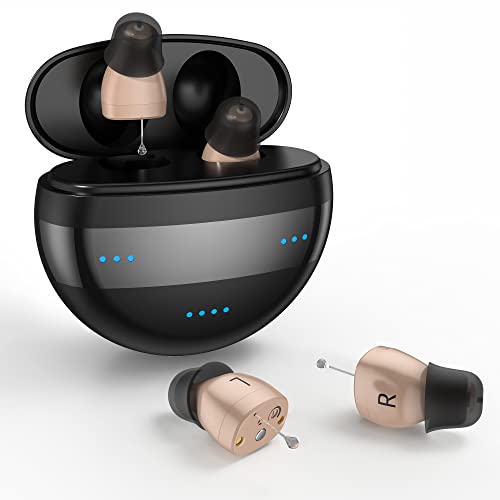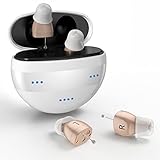Top 10 Cros Hearing Aids
What Are Cros Hearing Aids?
Cros hearing aids are designed to help those who experience unilateral hearing loss, or deafness in one ear. They consist of two devices: a transmitter that sits on the non-hearing side and picks up sounds from that environment, and a receiver that sits on the good ear and amplifies those sounds. The Cros system is particularly useful for people with no usable hearing in one ear, as it allows them to hear sound from both sides without having to turn their head towards the sound source. It also helps improve speech understanding by reducing background noise. One thing to note about Cros hearing aids is that they are not suitable for people with symmetrical hearing loss – where both ears have similar levels of impairment. In such cases, binaural (two-eared) fittings may be more appropriate. Cros systems can come in different styles – behind-the-ear (BTE), receiver-in-canal (RIC), completely-in-canal (CIC) – depending on your preference and lifestyle needs. Consult with your audiologist or healthcare provider to determine which type suits you best.How Do Cros Hearing Aids Work?
CROS hearing aids, or Contralateral Routing of Signal, are designed to help individuals with single-sided deafness. These types of hearing aids work by transferring sound from the non-hearing ear to the ear that has better hearing ability. The microphone in the CROS hearing aid picks up sounds from the deaf ear and transmits them wirelessly to a receiver in the other ear. The receiver then amplifies this sound and sends it directly into your good ear where it is processed as normal. One important thing to note about CROS systems is that they do not restore normal binaural (two-eared) function. Instead, they provide access to auditory information on both sides of your head through one functioning ear. There are two main types of Cros Hearing Aids available today: wireless streaming models and conventional models. Wireless streaming models use Bluetooth technology for audio transmission while conventional models rely on cables or wires instead. Cros Hearing Aids can help improve speech understanding, reduce listening effort and fatigue, and enhance overall communication abilities for those with single-sided deafness.The Different Types of Cros Hearing Aids
When it comes to Cros hearing aids, there are a few different types available on the market. Each type has its own set of features and benefits, so it’s important to understand what your options are before making a purchase. The first type is the traditional Cros hearing aid. This style typically consists of two separate devices: one that sits behind your ear and another that rests in your non-hearing ear. The device behind your ear picks up sound from that side and transmits it wirelessly to the device in your other ear, allowing you to hear sounds from both sides. Another option is a BiCros hearing aid, which is similar to the traditional Cros but also amplifies sound in the non-hearing ear. This can be especially helpful if you have some degree of hearing loss in that ear as well. There are also newer options such as rechargeable Cros hearing aids or those with Bluetooth connectivity for streaming audio directly from your phone or other devices. Ultimately, choosing the right type of Cros hearing aid depends on your specific needs and preferences. It’s always best to consult with an audiologist who can help guide you towards the best option for you.Factors to Consider Before Buying Cros Hearing Aids
When considering purchasing Cros hearing aids, there are several factors that should be taken into account. One of the most important is the severity and type of hearing loss you have. It’s important to choose a device specifically designed for your specific needs. Another factor to consider is your personal lifestyle and daily routine. Do you spend a lot of time outdoors or in noisy environments? This will impact which Cros hearing aid model would work best for you. Additionally, it’s important to think about the size and design of the device as well as its level of comfort. It’s also essential to consider any additional features that may be beneficial such as Bluetooth connectivity or rechargeable batteries. These features can improve convenience and ease-of-use. Cost is another factor that should not be overlooked when purchasing Cros hearing aids. While it’s understandable to want an affordable option, it’s crucial not to sacrifice quality for price. Selecting a reputable brand with positive consumer reports can provide peace-of-mind and ensure satisfaction with your purchase.Benefits of Using Cros Hearing Aids
Cros hearing aids are designed to bridge the gap between individuals with single-sided deafness or significant hearing loss in one ear. These devices work by transmitting sounds from the non-hearing ear to the better-performing ear, allowing for a more natural listening experience. One of the most significant benefits of using Cros hearing aids is improved sound localization. With traditional hearing aids, it can be challenging to determine where sounds are coming from – but with cros technology, wearers can easily distinguish sound sources and locate them accurately. Another advantage of Cros hearing aids is that they help reduce background noise. By transmitting only necessary sounds and filtering out unnecessary ones, these devices make it easier for users to hear conversations even in noisy environments like restaurants or bars. Cros hearing aids can also help improve speech recognition in difficult listening situations such as group gatherings or when communicating over long distances. Improved speech clarity leads to better communication effectiveness overall – a vital aspect of daily life. Wearing Cros hearing aids has been linked to an increase in social confidence and self-esteem among users who previously felt isolated due to their hearing impairment. The ability to communicate effectively without feeling embarrassed or frustrated has profound effects on mental health and wellbeing.The Pros and Cons of Cros Hearing Aids
Cros hearing aids have their own set of advantages and disadvantages, which should be considered before making a decision to purchase them. One of the biggest pros is that they are helpful for individuals who have one functioning ear and one non-functioning ear. Cros hearing aids pick up sounds from the non-functioning ear and transmit it to the other functioning ear so that the person can hear better. This helps in improving speech clarity, especially in noisy environments. Another advantage is that Cros hearing aids come in different styles such as behind-the-ear (BTE) or completely-in-canal (CIC), giving users options for comfort and discretion. However, there are also some cons associated with Cros hearing aids. Firstly, they may not be suitable for those with normal hearing in one ear as they only amplify sound from the non-functioning side. Secondly, wearing two separate devices could sometimes lead to discomfort or difficulty adjusting to them. Cros hearing aids might require additional accessories like a remote microphone or transmitter which can increase cost and complexity. It’s important to weigh both sides when considering whether these types of devices are right for you or your loved ones.Tips For Setting Up Your Cros Hearing Aids
Setting up your Cros hearing aids can take some time and effort. However, it is necessary to follow the steps carefully in order to ensure that you get the best results from your device. The first step is to read through the user manual that came with your hearing aid. This will give you a clear idea of how to set up and use your device properly. Next, make sure that you have all of the accessories that come with the hearing aid, such as batteries or charging devices. It’s important to have everything handy before starting the setup process. When setting up your Cros hearing aid, be sure to adjust the volume settings according to your individual needs. Start at a low volume level and gradually increase until it sounds comfortable for you. It’s also essential that you position the microphone on your non-hearing ear correctly so that it can capture sound effectively. If positioned incorrectly, it may pick up unwanted background noise instead of what you want to hear clearly. Always test out different environmental settings while wearing your Cros hearing aid. This will help determine which settings work best for various situations such as noisy environments or quiet ones.FAQs
FAQs (Frequently Asked Questions) are an essential part of every product review or buying guide. When it comes to Cros Hearing Aids, there are always questions that people want answered before making a purchase decision. One common question is: “What makes Cros hearing aids different from other types?” The answer lies in the technology used by Cros hearing aids, which allows sound amplification from the non-hearing ear to be transmitted to the ear with better hearing ability. This feature helps individuals who have unilateral hearing loss. Another frequently asked question is: “How comfortable are Cros hearing aids?” Comfort depends on personal preferences and how well they fit in your ear. It’s important to choose a model that suits your lifestyle and offers maximum comfort. People also ask about battery life, maintenance, and reliability of these devices. Cros Hearing Aids typically use disposable batteries which can last up to 7-10 days depending on usage frequency. Regular cleaning and maintenance will help prolong their lifespan while ensuring optimal performance. Some people may wonder if wearing a Cros device would make them feel self-conscious or embarrassed in public settings. However, modern-day designs aim for discretion so that no one can tell you’re using a device unless they look closely at it. Understanding FAQs about any product helps you make informed decisions when purchasing things like cros hearing aids..I’m Ella Andrews, owner of the website https://bestconsumerstips.com/
I give you valuable information about good products to help you choose the best product.











